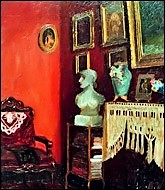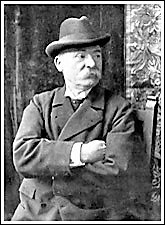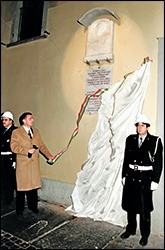


With the Franklin Public Library project done, Juglaris returned again to Turin. Based upon his American teaching career, he was known and respected among Italian colleagues as il professore—“The Professor.” Continuing with his career, Juglaris received various commissions for portraits, murals, and decorative projects. Prominent among them were invitations to paint murals for a private chapel in the home of the Baron des Planches, former Italian ambassador to the United States, and to complete the Stations of the Cross at the Holy Trinity Church in lower Moncalieri. Other projects included a portrait of Saint Margherita of Cortona for Moncalieri’s Saint Francesco Church and a ceiling for the Palace of the Embassies in Turin that served as a residence for the famous poet and novelist Edmondo De Amicis.


For a time Juglaris chose to live in grand style in a country villa purchased in the village of Piossasco, twenty kilometers from Turin. But he came to rue both the isolation and expense of his rustic retreat, particularly during the First World War Era when inflation eroded both his income and savings. Ultimately, Juglaris decided to spend his last days in his native town of Moncalieri. There, attended by a devoted housekeeper he lived comfortably in the upstairs apartment of a palazzo on a street leading from Moncalieri’s town square to the royal castle. Despite retirement, he took on occasional students. Among them was Bartolomeo Piovano who painted Juglaris’s red drawing room, providing us with a glimpse of his final home.
Juglaris passed away at the age of eighty on January 16, 1925. Juglaris requested that all funeral arrangements be kept simple with only a small marble bas relief to mark his place of burial in Moncalieri’s municipal cemetery. His request was honored. However, Juglaris’s name and earlier reputation were not lost to oblivion. On March 13, 1925, just three months after he died, Moncalieri’s Municipal Council saw fit to further memorialize their native son with a proclamation. Penned by the Counsel General Cleto Angelotti, it summed up some of the paradox surrounding Juglaris and his career. As Angelotti noted, Juglaris “was not honored in this, the city of his birth, nor even at his death, at he would have deserved. Too modest and too proud at the same time, he lived too much apart; and then, if the truth is to be told, he did his best work too far from us, in time [as well as place]. We must also remember that he was one of not many Italians (not many in relation to the great mass of emigrants) who honored Italy abroad, not only with their talent and their professional attitude, but also with their personal integrity and dignity. Let us therefore honor the memory of our fellow citizen of Moncalieri, the painter Tommaso Juglaris.”


Periodically, the City of Moncalieri has continued to remember Juglaris. In 1963, both a garden and a street were dedicated in his memory. Moreover, in Fall 2001, Juglaris’s memorial bas relief was removed from the municipal cemetery for cleaning and restoration. It was subsequently relocated to a more prominent site on the exterior wall of the palazzo where Juglaris lived his last days—a building that now serves as an extension of Moncalieri’s city hall. Added directly beneath the bas relief was a new marble historical tablet acknowledging both Juglaris and his eminent friend, Leonardo Bistolfi, who sculpted the original memorial. Amid larger festivities that included a specially-commissioned ballet inspired by Michigan’s Capitol muses and performed by a local dance troupe, the bas relief and historical tablet were formally unveiled and dedicated in January 2002. With images of the muses as a backdrop and members of the local carabinieri standing at attention, Moncalieri’s mayor and cultural leaders presided at the commemorative ceremony, coinciding with the anniversary of his death.
Juglaris’s modesty and the simplicity of his final departure belies the impressiveness of the legacy he left behind. In America, Juglaris’s legacy is not only to be found in his notable mural works which survive at the Michigan State Capitol and the Franklin Public Library but also in the appreciative testimony of his students, like Childe Hassam and Sears Gallagher. It finds even more vital expression in the accomplishments of all the students he cultivated and nurtured.
Tastes change. Our expectations of art do too. During his lifetime, critics sometimes complained that Juglaris’s art was stiff, heavy, and lacking in “poetic element.” Subsequent generations have tended to regard academic painting—which Juglaris taught and favored in his own work—as too formal, stilted, and tradition-bound. Yet Juglaris’s talent, which encouraged and inspired so many, still shines through the best of his work. His entire career as artist and teacher offers a link between the art of the past and the art of the present, part of the foundation which we appreciate and value in art today.